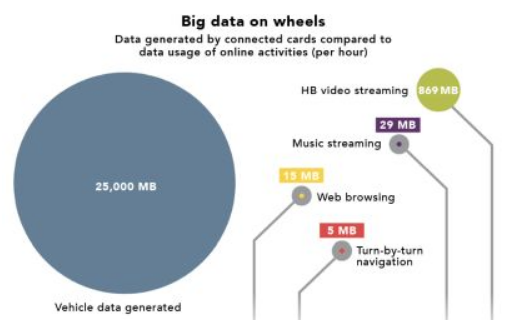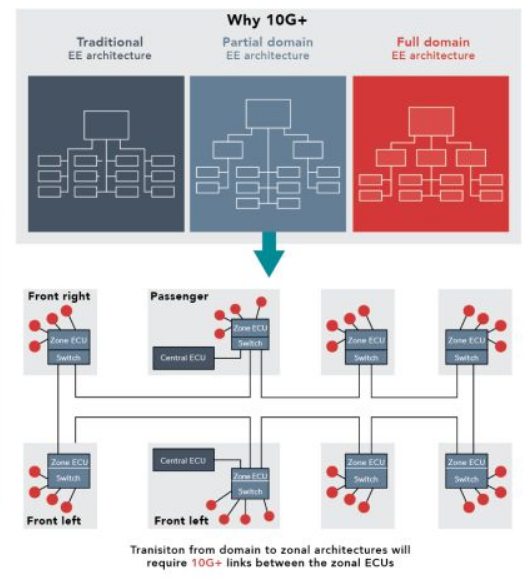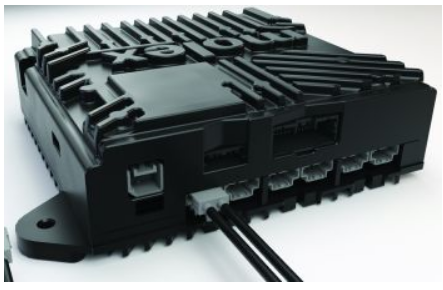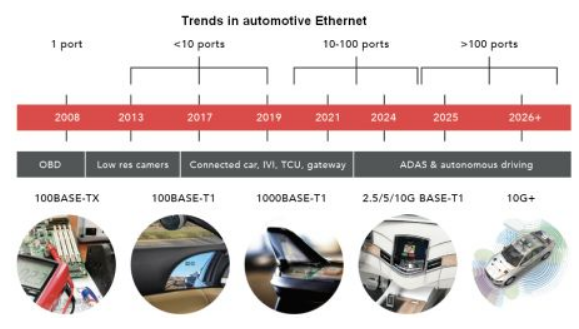By Harsh Patel, Molex
It is predicted that there will be 250 million connected cars and 10 million self-driving cars in 2020, and 470 million connected/self-driving cars in 2025.
The amount of data used by vehicles will increase significantly

Analysts at Statistica created these charts based on data from McKinsey estimates that connected cars create 25 gigabytes of data per hour, which is equivalent to nearly 30 hours of HD video playback or more than a month of continuous music streaming.
As the number of connected cars increases, the amount of data they generate, transmit and receive also increases. McKinsey says that the amount of data transmitted through connected vehicles (including data connected to the cloud) is about 25 GB/hour, and once vehicles achieve true autonomy, this number will rise to nearly 500 GB of data/hour.
Challenges facing vehicle network transmission protocols
Today's in-vehicle networks actually use a combination of several different data network protocols, some of which have been around for decades. They include the CAN bus, which handles powertrains and actuators; the LIN bus, which handles non-time-sensitive applications such as climate control, ambient lighting, seat adjustments, and more; the media-oriented system transmission MOST bus for infotainment; and the FlexRay bus for anti-lock braking, electronic power steering, and vehicle stability functions.
Vehicle networks under different protocols must require infrastructure including gateways, which is not the best solution. One is that the wiring of each network will increase the weight of the car, where the wiring harness is the third heaviest component in the vehicle (after the engine and chassis).
Today's automotive networks also contain many electronic control units (ECUs), and the number of ECUs in typical vehicles is also increasing. It is not uncommon for luxury models to carry 150 ECUs, while ordinary vehicles may have as many as 90 ECUs.
Automotive designers have concluded that data-intensive applications that support advanced driver assistance systems (ADAS) cannot be handled by the automotive network technology used today. The entire approach to in-vehicle networks must be fundamentally changed, both in terms of topology and underlying network technology.
Today, the network structures used in vehicles are moving towards a so-called domain-based architecture (each car manufacturer has its own architecture, but the main concepts are usually similar). Where older vehicle networks had dedicated ECUs and dedicated bus systems, domain architectures were characterized by a different domain for each key function: one ECU and network handling body control, one ECU/network for infotainment, one for telematics, one for powertrain, and so on. At least for now, these domains are still usually a mix of different network protocols (CAN, LIN, etc.). Today, the
network structures used in vehicles are moving towards a variant of the so-called domain-based architecture. Domain architectures are characterized by a different domain for each key function: one ECU and network handling body control, one ECU/network for infotainment, one for telematics, one for powertrain, and so on. As networks become more complex, this domain-based approach becomes increasingly inefficient. Therefore, there is a migration from a domain-based architecture to a type of so-called zonal architecture. As
networks become more complex, this domain-based approach becomes increasingly inefficient. Therefore, there is a migration from a domain-based architecture to a type of so-called zonal architecture.
The regional architecture connects data from different traditional domains to the same ECU based on the location (region) of the ECU in the vehicle. This scheme greatly reduces the number of wire harnesses and can handle multi-functional integration using discrete Ethernet wiring.
Unlike other in-vehicle network protocols, Ethernet has a clear development roadmap and plans for higher speeds. In contrast, traditional automotive protocols such as CAN and LIN have a capacity ceiling and there is no clear upgrade path to solve these problems.

It is expected that most data transmission within the vehicle will be carried out over Ethernet, so the plan is for a single homogeneous network throughout the vehicle. It is scalable, supporting higher speeds (such as 10G) with ultra-low latency. Designers will choose the appropriate Ethernet physical layer (PHY) for specific functions based on bandwidth requirements. Therefore, data-rich image sensors such as radar and lidar may use a 1 Gbps interface, while some other low data rate sensors may only require a 10 Mbps connection interface.
The regional architecture will use Ethernet switches to manage data from all different domain activities. Different data domains will be connected to local switches, and then the Ethernet backbone will aggregate the data. In this way, the network can use the same core protocol to support applications of different rates.

An example of automotive Ethernet: Molex 10 Gb Ethernet Gateway with 25 Gbps+ Molex HSAutoGig Interconnect Solution. It supports the signal integrity margin required for automotive sensors, cameras, gateways and switches, which are important components of future autonomous vehicles.
Ethernet standards will unify in-vehicle networks
Currently, the automotive industry and related suppliers are working to standardize automotive Ethernet, known as the IEEE 802.3CH standard for high-speed automotive Ethernet applications over 15 meters (2.5G, 5G and 10G automotive Ethernet), with optional PoDL (power over data line). The first version of the standard will be released at the end of this year. It is a product of the Multi-Gig Automotive Ethernet Task Group (NGAUTO), which aims to define the quality and operation processes at speeds of 2.5 Gbps, 5 Gbps and 10 Gbps.
The trend of vehicle networking has led to efforts aimed at standardizing automotive Ethernet. The automotive Ethernet specification currently underway is IEEE 802.3CH for high-speed automotive Ethernet applications over 15 meters (multi-gigabit automotive Ethernet for 2.5G, 5G and 10G), with optional PoDL (power over data line), and the first version of the standard will be released at the end of this year.
The IEEE has also set up a study group under the 802.3 Ethernet Working Group for automotive Ethernet over 10Gbps, which is a relatively new development and it may take some time before any standards for 10 Gbps Ethernet emerge.

The roadmap for the development of automotive Ethernet
5G is the second major development of Internet of Vehicles
Another trend affecting connected vehicles is the move to 5G, with major telecom operators beginning to launch fifth-generation (5G) wireless networks in metropolitan areas. The advent of 5G could take smart and autonomous driving technologies to the next level by enabling faster data rates and secure vehicle-to-vehicle (V2V) and vehicle-to-infrastructure (V2X) connections. Expected to be widely adopted within a few years, 5G requires continued progress in the development of robust network infrastructure and on-board processing technology to ensure reliable signal transmission and ultra-low latency bandwidth.
To explain what 5G means for automotive connectivity, AutoAir is being tested at the Millbrook Proving Ground in the UK, where researchers have built base stations, antennas, and other hardware to achieve a 1 Gbps connection to vehicles at speeds of up to 160 mph.
Nissan demonstrated a 5G implementation called Invisible-to-Visible at CES 2019 that uses fast connections to see around corners and alert drivers to potential hazards, such as obstacles in the road or pedestrians obscured by vehicles. Similarly, Ford is working with Vodafone to develop a system that uses 5G to warn cars of approaching emergency vehicles.
These high-speed automotive solutions require a level of expertise and engineering that exceeds many other applications. Much of the design complexity comes from features such as connectors, cable assemblies, and small footprint. It is no longer enough for hardware connectors to meet simple parameters such as low contact resistance and corrosion resistance. High-speed data processing must address electromagnetic interference issues and must address attenuation, return loss, mode conversion, crosstalk, impedance, and other elements that can affect signal transmission. Connectors in particular need to reliably deliver high-speed, high-bandwidth, and high-power signals to every sensor in the vehicle.
As a result, automakers are asking suppliers to create short-term solutions that can be implemented with existing infrastructure but can evolve to meet future needs. Suppliers are working to meet and expand high-speed data capabilities to meet automakers' requirements for higher levels of connectivity, including V2V, V2X, and fully autonomous driving.
Previous article:Quanta Computer invests in Japanese startup to develop ECU reference model for autonomous vehicles
Next article:48-volt full hybrid vehicles are coming soon, says IDTechEx Research
- Popular Resources
- Popular amplifiers
- A new chapter in Great Wall Motors R&D: solid-state battery technology leads the future
- Naxin Micro provides full-scenario GaN driver IC solutions
- Interpreting Huawei’s new solid-state battery patent, will it challenge CATL in 2030?
- Are pure electric/plug-in hybrid vehicles going crazy? A Chinese company has launched the world's first -40℃ dischargeable hybrid battery that is not afraid of cold
- How much do you know about intelligent driving domain control: low-end and mid-end models are accelerating their introduction, with integrated driving and parking solutions accounting for the majority
- Foresight Launches Six Advanced Stereo Sensor Suite to Revolutionize Industrial and Automotive 3D Perception
- OPTIMA launches new ORANGETOP QH6 lithium battery to adapt to extreme temperature conditions
- Allegro MicroSystems Introduces Advanced Magnetic and Inductive Position Sensing Solutions
- TDK launches second generation 6-axis IMU for automotive safety applications
- LED chemical incompatibility test to see which chemicals LEDs can be used with
- Application of ARM9 hardware coprocessor on WinCE embedded motherboard
- What are the key points for selecting rotor flowmeter?
- LM317 high power charger circuit
- A brief analysis of Embest's application and development of embedded medical devices
- Single-phase RC protection circuit
- stm32 PVD programmable voltage monitor
- Introduction and measurement of edge trigger and level trigger of 51 single chip microcomputer
- Improved design of Linux system software shell protection technology
- What to do if the ABB robot protection device stops
- Detailed explanation of intelligent car body perception system
- How to solve the problem that the servo drive is not enabled
- Why does the servo drive not power on?
- What point should I connect to when the servo is turned on?
- How to turn on the internal enable of Panasonic servo drive?
- What is the rigidity setting of Panasonic servo drive?
- How to change the inertia ratio of Panasonic servo drive
- What is the inertia ratio of the servo motor?
- Is it better for the motor to have a large or small moment of inertia?
- What is the difference between low inertia and high inertia of servo motors?
- MSP430IO Driver
- Why is there no sound after the voice IC is connected to the power amplifier circuit?
- I'm a newbie, please KP
- Use the MP3 decoding library provided by ST
- How do I design a circuit with such input and output?
- Board burning problem
- X-NUCLEO-IKS01A3 driver for Arduino
- Nordic Bluetooth sensor monitors guitar temperature and humidity
- EEWORLD University Hall - Altium Designer 22 Electronic Design Introduction Practice 56 Lectures
- ztool cannot connect

 OP-50BY/883
OP-50BY/883











 京公网安备 11010802033920号
京公网安备 11010802033920号